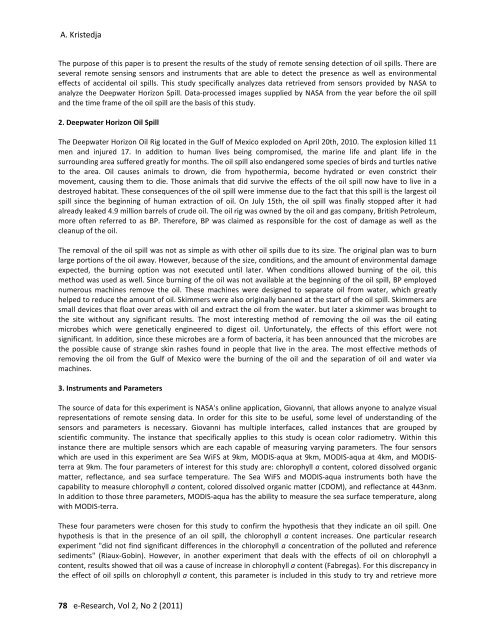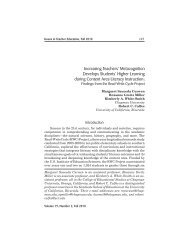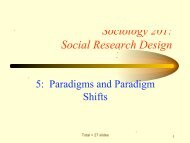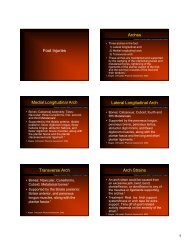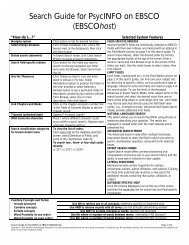e-Research: A Journal of Undergraduate Work - Chapman University
e-Research: A Journal of Undergraduate Work - Chapman University
e-Research: A Journal of Undergraduate Work - Chapman University
You also want an ePaper? Increase the reach of your titles
YUMPU automatically turns print PDFs into web optimized ePapers that Google loves.
A. Kristedja<br />
The purpose <strong>of</strong> this paper is to present the results <strong>of</strong> the study <strong>of</strong> remote sensing detection <strong>of</strong> oil spills. There are<br />
several remote sensing sensors and instruments that are able to detect the presence as well as environmental<br />
effects <strong>of</strong> accidental oil spills. This study specifically analyzes data retrieved from sensors provided by NASA to<br />
analyze the Deepwater Horizon Spill. Data-processed images supplied by NASA from the year before the oil spill<br />
and the time frame <strong>of</strong> the oil spill are the basis <strong>of</strong> this study.<br />
2. Deepwater Horizon Oil Spill<br />
The Deepwater Horizon Oil Rig located in the Gulf <strong>of</strong> Mexico exploded on April 20th, 2010. The explosion killed 11<br />
men and injured 17. In addition to human lives being compromised, the marine life and plant life in the<br />
surrounding area suffered greatly for months. The oil spill also endangered some species <strong>of</strong> birds and turtles native<br />
to the area. Oil causes animals to drown, die from hypothermia, become hydrated or even constrict their<br />
movement, causing them to die. Those animals that did survive the effects <strong>of</strong> the oil spill now have to live in a<br />
destroyed habitat. These consequences <strong>of</strong> the oil spill were immense due to the fact that this spill is the largest oil<br />
spill since the beginning <strong>of</strong> human extraction <strong>of</strong> oil. On July 15th, the oil spill was finally stopped after it had<br />
already leaked 4.9 million barrels <strong>of</strong> crude oil. The oil rig was owned by the oil and gas company, British Petroleum,<br />
more <strong>of</strong>ten referred to as BP. Therefore, BP was claimed as responsible for the cost <strong>of</strong> damage as well as the<br />
cleanup <strong>of</strong> the oil.<br />
The removal <strong>of</strong> the oil spill was not as simple as with other oil spills due to its size. The original plan was to burn<br />
large portions <strong>of</strong> the oil away. However, because <strong>of</strong> the size, conditions, and the amount <strong>of</strong> environmental damage<br />
expected, the burning option was not executed until later. When conditions allowed burning <strong>of</strong> the oil, this<br />
method was used as well. Since burning <strong>of</strong> the oil was not available at the beginning <strong>of</strong> the oil spill, BP employed<br />
numerous machines remove the oil. These machines were designed to separate oil from water, which greatly<br />
helped to reduce the amount <strong>of</strong> oil. Skimmers were also originally banned at the start <strong>of</strong> the oil spill. Skimmers are<br />
small devices that float over areas with oil and extract the oil from the water. but later a skimmer was brought to<br />
the site without any significant results. The most interesting method <strong>of</strong> removing the oil was the oil eating<br />
microbes which were genetically engineered to digest oil. Unfortunately, the effects <strong>of</strong> this effort were not<br />
significant. In addition, since these microbes are a form <strong>of</strong> bacteria, it has been announced that the microbes are<br />
the possible cause <strong>of</strong> strange skin rashes found in people that live in the area. The most effective methods <strong>of</strong><br />
removing the oil from the Gulf <strong>of</strong> Mexico were the burning <strong>of</strong> the oil and the separation <strong>of</strong> oil and water via<br />
machines.<br />
3. Instruments and Parameters<br />
The source <strong>of</strong> data for this experiment is NASA's online application, Giovanni, that allows anyone to analyze visual<br />
representations <strong>of</strong> remote sensing data. In order for this site to be useful, some level <strong>of</strong> understanding <strong>of</strong> the<br />
sensors and parameters is necessary. Giovanni has multiple interfaces, called instances that are grouped by<br />
scientific community. The instance that specifically applies to this study is ocean color radiometry. Within this<br />
instance there are multiple sensors which are each capable <strong>of</strong> measuring varying parameters. The four sensors<br />
which are used in this experiment are Sea WiFS at 9km, MODIS-aqua at 9km, MODIS-aqua at 4km, and MODISterra<br />
at 9km. The four parameters <strong>of</strong> interest for this study are: chlorophyll a content, colored dissolved organic<br />
matter, reflectance, and sea surface temperature. The Sea WiFS and MODIS-aqua instruments both have the<br />
capability to measure chlorophyll a content, colored dissolved organic matter (CDOM), and reflectance at 443nm.<br />
In addition to those three parameters, MODIS-aqua has the ability to measure the sea surface temperature, along<br />
with MODIS-terra.<br />
These four parameters were chosen for this study to confirm the hypothesis that they indicate an oil spill. One<br />
hypothesis is that in the presence <strong>of</strong> an oil spill, the chlorophyll a content increases. One particular research<br />
experiment "did not find significant differences in the chlorophyll a concentration <strong>of</strong> the polluted and reference<br />
sediments" (Riaux-Gobin). However, in another experiment that deals with the effects <strong>of</strong> oil on chlorophyll a<br />
content, results showed that oil was a cause <strong>of</strong> increase in chlorophyll a content (Fabregas). For this discrepancy in<br />
the effect <strong>of</strong> oil spills on chlorophyll a content, this parameter is included in this study to try and retrieve more<br />
78 e-<strong>Research</strong>, Vol 2, No 2 (2011)


